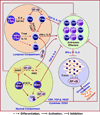The immunological contribution of NF-κB within the tumor microenvironment: a potential protective role of zinc as an anti-tumor agent
- PMID: 22155217
- PMCID: PMC3811120
- DOI: 10.1016/j.bbcan.2011.11.002
The immunological contribution of NF-κB within the tumor microenvironment: a potential protective role of zinc as an anti-tumor agent
Abstract
Over decades, cancer treatment has been mainly focused on targeting cancer cells and not much attention to host tumor microenvironment. Recent advances suggest that the tumor microenvironment requires in-depth investigation for understanding the interactions between tumor cell biology and immunobiology in order to optimize therapeutic approaches. Tumor microenvironment consists of cancer cells and tumor associated reactive fibroblasts, infiltrating non-cancer cells, secreted soluble factors or molecules, and non-cellular support materials. Tumor associated host immune cells such as Th(1), Th(2), Th17, regulatory cells, dendritic cells, macrophages, and myeloid-derived suppressor cells are major components of the tumor microenvironment. Accumulating evidence suggests that these tumor associated immune cells may play important roles in cancer development and progression. However, the exact functions of these cells in the tumor microenvironment are poorly understood. In the tumor microenvironment, NF-κB plays an important role in cancer development and progression because this is a major transcription factor which regulates immune functions within the tumor microenvironment. In this review, we will focus our discussion on the immunological contribution of NF-κB in tumor associated host immune cells within the tumor microenvironment. We will also discuss the potential protective role of zinc, a well-known immune response mediator, in the regulation of these immune cells and cancer cells in the tumor microenvironment especially because zinc could be useful for conditioning the tumor microenvironment toward innovative cancer therapy.
Copyright © 2011 Elsevier B.V. All rights reserved.
Figures

Similar articles
-
Immunomodulatory Function of the Tumor Suppressor p53 in Host Immune Response and the Tumor Microenvironment.Int J Mol Sci. 2016 Nov 19;17(11):1942. doi: 10.3390/ijms17111942. Int J Mol Sci. 2016. PMID: 27869779 Free PMC article. Review.
-
Lipopolysaccharides-stimulated macrophage products enhance Withaferin A-induced apoptosis via activation of caspases and inhibition of NF-κB pathway in human cancer cells.Mol Immunol. 2017 Jan;81:92-101. doi: 10.1016/j.molimm.2016.10.010. Epub 2016 Dec 1. Mol Immunol. 2017. PMID: 27915154
-
Tumor Immune Microenvironment and Its Related miRNAs in Tumor Progression.Front Immunol. 2021 May 18;12:624725. doi: 10.3389/fimmu.2021.624725. eCollection 2021. Front Immunol. 2021. PMID: 34084160 Free PMC article.
-
NF-κB signaling pathway in tumor microenvironment.Front Immunol. 2024 Oct 18;15:1476030. doi: 10.3389/fimmu.2024.1476030. eCollection 2024. Front Immunol. 2024. PMID: 39493763 Free PMC article. Review.
-
Notch and NF-κB: Coach and Players of Regulatory T-Cell Response in Cancer.Front Immunol. 2018 Oct 11;9:2165. doi: 10.3389/fimmu.2018.02165. eCollection 2018. Front Immunol. 2018. PMID: 30364244 Free PMC article. Review.
Cited by
-
NF-κB signaling in neoplastic transition from epithelial to mesenchymal phenotype.Cell Commun Signal. 2023 Oct 18;21(1):291. doi: 10.1186/s12964-023-01207-z. Cell Commun Signal. 2023. PMID: 37853467 Free PMC article. Review.
-
The IKK inhibitor Bay 11-7082 induces cell death independent from inhibition of activation of NFκB transcription factors.PLoS One. 2013;8(3):e59292. doi: 10.1371/journal.pone.0059292. Epub 2013 Mar 20. PLoS One. 2013. PMID: 23527154 Free PMC article.
-
The role of T helper (TH)17 cells as a double-edged sword in the interplay of infection and autoimmunity with a focus on xenobiotic-induced immunomodulation.Clin Dev Immunol. 2013;2013:374769. doi: 10.1155/2013/374769. Epub 2013 Sep 12. Clin Dev Immunol. 2013. PMID: 24151516 Free PMC article. Review.
-
Zinc Transporters Serve as Prognostic Predictors and their Expression Correlates with Immune Cell Infiltration in Specific Cancer: A Pan-cancer Analysis.J Cancer. 2024 Jan 1;15(4):939-954. doi: 10.7150/jca.87880. eCollection 2024. J Cancer. 2024. PMID: 38230214 Free PMC article.
-
Investigations of the functional states of dendritic cells under different conditioned microenvironments by Fourier transformed infrared spectroscopy.Biomed Eng Online. 2014 Jan 10;13:2. doi: 10.1186/1475-925X-13-2. Biomed Eng Online. 2014. PMID: 24410930 Free PMC article.
References
-
- Alvaro T, de la Cruz-Merino L, Henao-Carrasco F, Villar Rodríguez JL, Vicente Baz D, Codes Manuel de Villena M, Provencio M. Tumor microenvironment and immune effects of antineoplastic therapy in lymphoproliferative syndromes. J. Biomed. Biotechnol. 2010 (2010) [Electronic publication ahead of print, 2010 Aug 12]. Review. - PMC - PubMed
-
- Banchereau J, Briere F, Caux C, Davoust J, Lebecque S, Liu YJ, Pulendran B, Palucka K. Immunobiology of dendritic cells. Annu. Rev. Immunol. 2000;18:767–811. - PubMed
-
- Cretu A, Brooks PC. Impact of the non-cellular tumor microenvironment on metastasis: potential therapeutic and imaging opportunities. J. Cell. Physiol. 2007;213:391–402. - PubMed
Publication types
MeSH terms
Substances
Grants and funding
LinkOut - more resources
Full Text Sources

